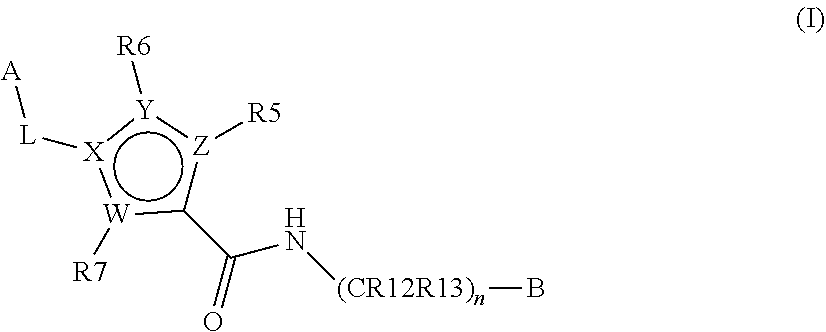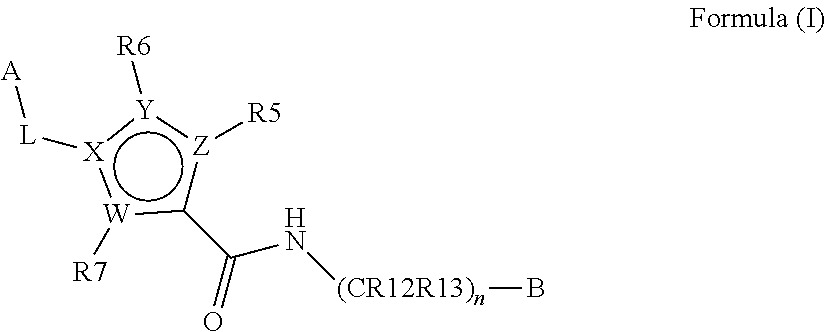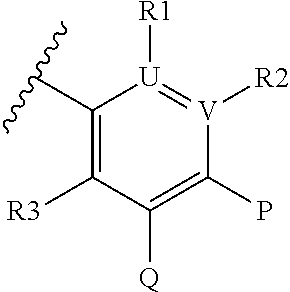Inhibitors of plasma kallikrein
a technology of plasma kallikrein and inhibitors, which is applied in the field of inhibitors of plasma kallikrein, can solve the problems of limited molecule description in the known art, abnormal abundance of plasma kallikrein-kinin system, and increase in the solubility of compounds of formula (i) used in the preparation of parenteral solutions
- Summary
- Abstract
- Description
- Claims
- Application Information
AI Technical Summary
Benefits of technology
Problems solved by technology
Method used
Image
Examples
example 1
N-[(1-Aminoisoquinolin-6-yl)methyl]-5-({4-[(4-methylpyrazol-1-ylmethyl]phenyl}methyl)pyridine-3-carboxamide
[0372]
A. 5-(4,4,5,5-Tetramethyl-[1,3,2]dioxaborolan-2-yl)-nicotinic acid methyl ester
[0373]To a dried flask under N2 was added: 4,4,4′,4′,5,5,5′,5′-octamethyl-2,2′-bi(1,3,2-dioxaborolane) (0.441 g, 1.736 mmol), methyl 5-bromonicotinate (0.25 g, 1.157 mmol), potassium acetate (0.341 g, 3.47 mmol) and dry dioxane (10 mL). The reaction was degassed under nitrogen for 5 minutes before Pd(dppf)Cl2 (0.085 g, 0.116 mmol) was added to give a bright red solution. The reaction was heated to 80° C. for 16 h. The reaction mixture was partitioned between EtOAc (50 mL) and sat. aq. NH4Cl (30 mL). The aqueous layer was extracted with EtOAc (2×30 mL). The combined organic layers were washed with water (30 mL) then brine (20 mL) and dried (MgSO4), filtered and concentrated in vacuo to a brown oil which was used in the next step without further purification.
B. 5-[4-(4-Methyl-pyrazol-1-ylmethyl)-...
example 2
5-({4-[(4-Methylpyrazol-1-yl)methyl]phenyl}methyl)-N-{7H-pyrrolo[2,3-b]pyridin-5-ylmethyl}pyridine-3-carboxamide
[0381]
[0382]To a vial was added: 5-(4-((4-methyl-1H-pyrazol-1-yl)methyl)benzyl)nicotinic acid (48 mg, 0.156 mmol), (1H-pyrrolo[2,3-b]pyridin-5-yl)methanamine hydrochloride (28.7 mg, 0.156 mmol), HATU (65.3 mg, 0.172 mmol) and DCM (3.0 mL) to give a white suspension. Next, DIPEA (82 μl, 0.469 mmol) was added to give a colourless solution. The reaction was stirred at rt for 2 hrs over which time the colour changed to orange. LC-MS showed complete conversion to desired product. The reaction was partitioned between DCM (10 mL) and sat. NH4Cl (20 mL). MeOH (1 mL) was added to aid solubility. The aqueous layer was extracted with DCM (10 mL) before the combined organic layers were washed with water (10 mL) and dried (Na2SO4), filtered and concentrated in vacuo. The crude product was purified by chromatography on RediSep (12 g column, 0-10% MeOH (NH3) in DCM) and dried in a dessic...
example 3
N-[(1-Aminoisoquinolin-6-yl)methyl]-4-({4-[(4-methylpyrazol-1-ylmethyl]phenyl}methyl)pyridine-2-carboxamide
[0385]
A. 4-(4,4,5,5-Tetramethyl-[1,3,2]dioxaborolan-2-yl)-pyridine-2-carboxylic acid methyl ester
[0386]To an oven dried flask was added: methyl 4-bromopicolinate (0.5 g, 2.314 mmol), 4,4,4′,4′,5,5,5′,5′-octamethyl-2,2′-bi(1,3,2-dioxaborolane) (0.705 g, 2.78 mmol), potassium acetate (0.681 g, 6.94 mmol) and dry dioxane (20 mL). The solvent was degassed (N2) for 10 minutes before PdCl2(dppf) (0.085 g, 0.116 mmol) was added. The dark red solution was heated to 80° C. (base-plate temp.) for 20 h. The reaction mixture was partitioned between EtOAc (100 mL) and sat. aq. NH4Cl (50 mL). The aqueous layer was extracted with EtOAc (2×30 mL). The combined organic layers were washed with water (3×30 mL) then brine (20 mL), dried (MgSO4) and filtered. Concentration in vacuo afforded a brown oil identified as 4-(4,4,5,5-tetramethyl-[1,3,2]dioxaborolan-2-yl)-pyridine-2-carboxylic acid methyl ...
PUM
| Property | Measurement | Unit |
|---|---|---|
| weight | aaaaa | aaaaa |
| flow rate | aaaaa | aaaaa |
| flow rates | aaaaa | aaaaa |
Abstract
Description
Claims
Application Information
 Login to View More
Login to View More - R&D
- Intellectual Property
- Life Sciences
- Materials
- Tech Scout
- Unparalleled Data Quality
- Higher Quality Content
- 60% Fewer Hallucinations
Browse by: Latest US Patents, China's latest patents, Technical Efficacy Thesaurus, Application Domain, Technology Topic, Popular Technical Reports.
© 2025 PatSnap. All rights reserved.Legal|Privacy policy|Modern Slavery Act Transparency Statement|Sitemap|About US| Contact US: help@patsnap.com



